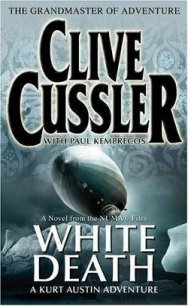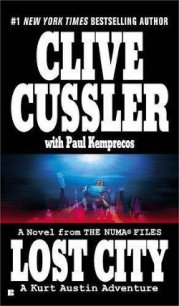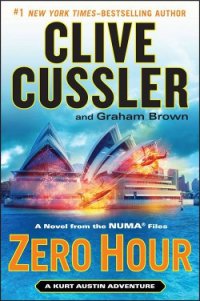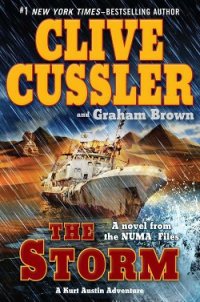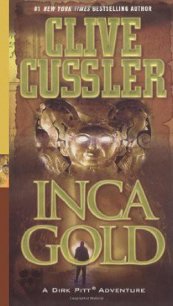The Navigator - Cussler Clive (читаем книги онлайн бесплатно полностью .TXT) 📗
“Where’s Kurt?” Saxon said.
“Called away unexpectedly,” Zavala said. He hid his misgivings about Austin’s mission with a cheerful smile.
“Damn shame,” Saxon said with disappointment. “Kurt’s going to miss all the fun when we find the mine.”
“You sound pretty confident,” Paul said.
“Joe knows from experience that I tend toward grandiose pronouncements. Showmanship goes with my occupation,” Saxon admitted. “But I would swear on Sheba’s grave that we have the mine within our grasp. I’ll show you.”
Saxon went over to his car and dropped down the tailgate. He snapped open his battered suitcase and extracted a thick wad of papers.
“You’ve been busy,” Zavala said.
“I’m bleary-eyed from staying up all night doing research,” Saxon said. “But it’s been worth it. This is a topographical map of the area of interest. And this diagram shows the old railroad that used to service the coal mines. Joe has probably filled you in,” he said to the Trouts, “but what drew me to this place were the persistent rumors of a legendary gold mine and Indian burial caves. There’s the Gold Mine Road, which winds through the mountains, and an abandoned village called Gold Mine.”
Trout surveyed the woods surrounding the quiet airstrip. His large brown eyes blinked, as they often did when his brain went into ponder mode.
“You’ll have to pardon my scientific skepticism,” he said with typical New England bluntness, “but it’s hard to believe that Phoenicians sailed from halfway across the world and found a gold mine in this pretty Pennsylvania countryside.”
“Skepticism is healthy,” Saxon said. “You have to look at the context. We see walking trails, sleepy villages, and farms. But this land was once inhabited by at least five tribes who lived in twenty villages. In 1600, when the Europeans rediscovered the place, there were nearly seven thousand Susquehannock Indians living in these hills and valleys.”
“What’s your theory on first contact?” Gamay asked.
“I believe a Phoenician scouting ship in search of copper heard about the gold from the Indians. With their skill at organization, the Phoenicians could have hired the locals to open the mine, refine the gold, and established land and sea routes to transport it home.”
“Difficult but not impossible,” Trout said with a nod of his head. “Did I understand you to say that you can actually lead us to the mine?”
“I can lead you to where I think it is. Hop in the car and we’ll go for a ride.”
They shifted their bags from the helicopter to the Suburban. Saxon drove from the airport onto a winding country road. After a few miles, he turned off the road and followed a pair of ruts into the woods.
“Welcome to St. Anthony’s Wilderness,” Saxon said as the vehicle bumped in and out of cratered potholes. “This is the second-largest roadless area in Pennsylvania. The Appalachian Trail runs through it. You’ve got fourteen thousand acres of woodlands between First and Second mountains.”
“I wasn’t aware that St. Anthony visited North America,” Gamay said.
“He didn’t. It was named after a missionary named Anthony Seyfert. The locals know it as StonyValley. It’s as quiet as the grave around here now, but in the 1800s hundreds of men and boys toiled in the coal mines. Rail lines came into the village of Rausch Gap, and later served the Cold Springs resort. Almost everyone left when the mines played out.”
“You said almost,” Zavala said.
Saxon nodded. “Some smart developers figured out a way to profit from the gold mine legend. They built a place called the Gold Stream Hotel. Tourists stayed at the hotel, and took boat rides into a cave—Pennsylvania is loaded with them. The highlight was the opportunity to pan for gold.”
“They actually found gold?” Gamay said.
“Enough to make the tourists happy. The hotel sold lockets to hold your gold dust. The hotel went out of business after the railroad pulled out.”
“There must have been a source for that gold dust,” Paul said.
Saxon grinned. “Absolutely right. That’s why I think the hotel is the key to unlocking this whole mystery.”
“How is that?” Zavala asked.
“You’ll see,” Saxon said mysteriously.
As the Suburban penetrated deeper into the woods, Saxon launched into a description of the wars between the Indians and the settlers, and pointed out ruins of the old mining camps and towers that marked mine shafts. The road ended abruptly at the shores of a lake. Saxon brought the Suburban to a stop.
“Welcome to the Hotel Gold Stream,” he said.
They got out of the car and followed Saxon down a gradual slope to the edge of a lake. Hardly a ripple marred the mirrorlike surface.
“The hotel is under the lake?” Zavala said.
“The hotel used to be in a valley,” Saxon said. “After the place was abandoned, gold hunters came in looking for the source. They had more dynamite than brains. They blew up a natural dam, and allowed the waters of a nearby creek to fill the valley and cover the hotel.”
Zavala walked over to the water’s edge and gazed out at the lake. He judged that it was about a mile wide and two miles long, and surrounded by thickly wooded hills. “How deep is it?”
“Nearly a hundred feet at its deepest point,” Saxon said. “The lake is spring-fed.”
“Standard dive procedure is to plan the dive and dive the plan,” Zavala said. “It’s a big lake. Any idea where we should start?”
“I’ll show you,” Saxon said.
Back at the Suburban, Saxon extracted a file marked HOTEL GOLD STREAM from his bag and handed Zavala a yellowed brochure that touted the features of the hotel, shown as a two-story flagstone building.
A walkway led from the hotel to stairs that went down to the cave entrance, where the tour boats were lined up. A sketch showed people in Victorian attire panning sluiceways for gold. Zavala looked from the hotel layout to the lake, trying to visualize what lay under the surface.
“No one could find the mine when the hotel was high and dry,” he said. “What makes you think it will be any easier under water?”
“The same question occurred to me,” Saxon said. “I was about to call off the expedition when I came across a magazine article about the lost hotel. One of the former kitchen staff described a trapdoor in the kitchen. It had been locked, but the kitchen staff broke the lock and dropped something down to see how deep it was. No one could hear it hit bottom. The management put a stronger lock on the trapdoor because the kitchen people were dumping peelings down the shaft.”
Paul said. “The air shaft could have been dug to ventilate a mine.”
Saxon opened a sketch pad to a page where he had made a reasonable copy of the hotel from the tourist brochure. Double vertical lines marked the air shaft.
“I think the hotel was built over the mine,” he said. “The cave may have been part of the mine entrance before the ceiling caved in. The cave-in blocked access but not the flow of gold-laden water. If we go down that shaft, we can get into the mine. Do you think it’s doable?”
Zavala studied the drawing for a moment, going through each step of the dive in his mind. “Any idea how big the shaft opening was?” he asked Saxon.
“No dimensions were given in the article.”
Zavala was a careful diver. He proposed a two-stage plan. He and Gamay would explore the cave first, then check out the shaft. Gamay was a highly skilled diver who had explored many wrecks in the Great Lakes and, later, worked as a nautical archaeologist. With their slim builds, they might be able to navigate the shaft.
While Paul inflated a rubber raft, the divers got into their scuba gear. Saxon had charted out the hotel location on a topographical map enclosed in waterproof plastic.
Trout paddled Gamay and Zavala out into the lake. They dropped a weighted marker buoy into the water. All was ready. The divers rolled over the sides of the raft and disappeared into the depths, with only ripples to mark their passage from one world to another.
